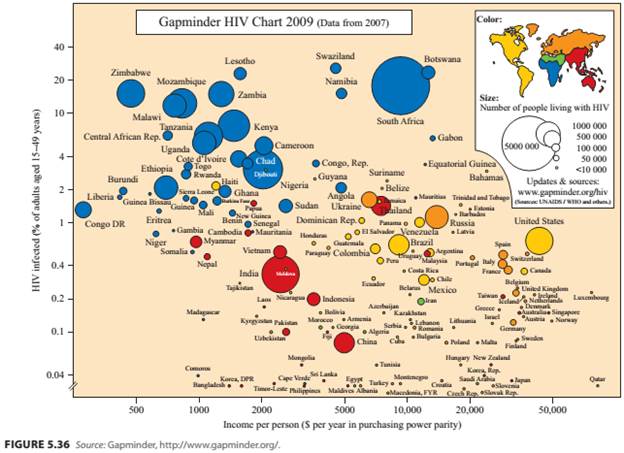
Concept explainers
HIV Distribution. Figure 5.36 displays the wealth of various countries (per capita income) and the percentage of adults infected with HIV in the same countries. The size of the bubble is proportional to the actual number of HIV-infected adults.
a. How is the location of countries indicated on the display? On what continent is Benin located?
b. Approximately how many people in South Africa live with HIV? What is the per capita income in that country?
c. Approximately how many people in india live with HIV? What is the per capita income in that country?
d. Discuss how incidence of HIV appears to be related to the wealth of a country.
e. What countries are notable exceptions to your conclusion in part (d)?

Want to see the full answer?
Check out a sample textbook solution
Chapter 5 Solutions
Using and Understanding Mathematics: A Quantitative Reasoning Approach plus NEW MyMathLab with Pearson eText -- Access Card Package (6th Edition) (Bennett Science & Math Titles)
- 4. (i) Let a discrete sample space be given by N = {W1, W2, W3, W4}, and let a probability measure P on be given by P(w1) = 0.2, P(w2) = 0.2, P(w3) = 0.5, P(wa) = 0.1. Consider the random variables X1, X2 → R defined by X₁(w1) = 1, X₁(w2) = 2, X2(w1) = 2, X2 (w2) = 2, Find the joint distribution of X1, X2. (ii) X1(W3) = 1, X₁(w4) = 1, X2(W3) = 1, X2(w4) = 2. [4 Marks] Let Y, Z be random variables on a probability space (, F, P). Let the random vector (Y, Z) take on values in the set [0, 1] x [0,2] and let the joint distribution of Y, Z on [0, 1] x [0,2] be given by 1 dPy,z (y, z) ==(y²z+yz2) dy dz. harks 12 Find the distribution Py of the random variable Y. [8 Marks]arrow_forwardNeed help answering wuestionarrow_forwardFor the following function, find the full power series centered at x = 0 and then give the first 5 nonzero terms of the power series and the open interval of convergence. f(x) = Σ| n=0 9 f(x) = 6 + 4x f(x)− + + + ++··· The open interval of convergence is: ☐ (Give your answer in help (intervals) .)arrow_forward
- marks 11 3 3/4 x 1/4 1. There are 4 balls in an urn, of which 3 balls are white and 1 ball is black. You do the following: draw a ball from the urn at random, note its colour, do not return the ball to the urn; draw a second ball, note its colour, return the ball to the urn; finally draw a third ball and note its colour. (i) Describe the corresponding discrete probability space (Q, F, P). [9 Marks] (ii) Consider the following event, A: Among the first and the third balls, one ball is white, the other is black. Write down A as a subset of the sample space and find its probability, P(A). [2 Marks]arrow_forwardThere are 4 balls in an urn, of which 3 balls are white and 1 ball isblack. You do the following:• draw a ball from the urn at random, note its colour, do not return theball to the urn;• draw a second ball, note its colour, return the ball to the urn;• finally draw a third ball and note its colour.(i) Describe the corresponding discrete probability space(Ω, F, P). [9 Marks](ii) Consider the following event,A: Among the first and the third balls, one ball is white, the other is black.Write down A as a subset of the sample space Ω and find its probability, P(A)arrow_forwardLet (Ω, F, P) be a probability space and let X : Ω → R be a randomvariable whose probability density function is given by f(x) = 12 |x|e−|x| forx ∈ R.(i) Find the characteristic function of the random variable X.[8 Marks](ii) Using the result of (i), calculate the first two moments of therandom variable X, i.e., E(Xn) for n = 1, 2. [6 Marks]Total marks 16 (iii) What is the variance of X?arrow_forward
- Let X be a random variable with the standard normal distribution, i.e.,X has the probability density functionfX(x) = 1/√2π e^-(x^2/2)2 .Consider the random variablesXn = 20(3 + X6) ^1/2n e ^x^2/n+19 , x ∈ R, n ∈ N.Using the dominated convergence theorem, prove that the limit exists and find it limn→∞E(Xn)arrow_forwardLet X be a discrete random variable taking values in {0, 1, 2, . . . }with the probability generating function G(s) = E(sX). Prove thatVar(X) = G′′(1) + G′(1) − [G′(1)]2.[5 Marks](ii) Let X be a random variable taking values in [0,∞) with proba-bility density functionfX(u) = (5/4(1 − u^4, 0 ≤ u ≤ 1,0, otherwise. Let y =x^1/2 find the probability density function of Yarrow_forward14 14 4. The graph shows the printing rate of Printer A. Printer B can print at a rate of 25 pages per minute. How does the printing rate for Printer B compare to the printing rate for Printer A? The printing rate for Printer B is than the rate for Printer A because the rate of 25 pages per minute is than the rate of for Printer A. pages per minute RIJOUT 40 fy Printer Rat Number of Pages 8N WA 10 30 20 Printer A 0 0 246 Time (min) Xarrow_forward
- 2. y 1 Ο 2 3 4 -1 Graph of f x+ The graph gives one cycle of a periodic function f in the xy-plane. Which of the following describes the behavior of f on the interval 39 x < 41 ? (Α B The function f is decreasing. The function f is increasing. The function f is decreasing, then increasing. D The function f is increasing, then decreasing.arrow_forwardDepth (feet) 5- 4- 3- 2. WW www 1 D B 0 10 20 30 40 50 60 70 80 Time (hours) x A graph of the depth of water at a pier in the ocean is given, along with five labeled points A, B, C, D, and E in the xy-plane. For the time periods near these data points, a periodic relationship between depth of water, in feet, and time, in hours, can be modeled using one cycle of the periodic relationship. Based on the graph, which of the following is true? B C The time interval between points A and B gives the period. The time interval between points A and C gives the period. The time interval between points A and D gives the period. The time interval between points A and E gives the period.arrow_forwardA certain type of machine produces a number of amps of electricity that follows a cyclic, periodically increasing and decreasing pattern. The machine produces a maximum of 7 amps at certain times and a minimum of 2 amps at other times. It takes about 5 minutes for one cycle from 7 amps to the next 7 amps to occur. Which of the following graphs models amps as a function of time, in minutes, for this machine? A B C D Amps M 3 4 5 678 Minutes Amps w 3 4 5 6 7 8 Minutes 8 Amps- 6+ Amps y 2345678 Minutes 456 8 Minutesarrow_forward
 Glencoe Algebra 1, Student Edition, 9780079039897...AlgebraISBN:9780079039897Author:CarterPublisher:McGraw Hill
Glencoe Algebra 1, Student Edition, 9780079039897...AlgebraISBN:9780079039897Author:CarterPublisher:McGraw Hill Holt Mcdougal Larson Pre-algebra: Student Edition...AlgebraISBN:9780547587776Author:HOLT MCDOUGALPublisher:HOLT MCDOUGAL
Holt Mcdougal Larson Pre-algebra: Student Edition...AlgebraISBN:9780547587776Author:HOLT MCDOUGALPublisher:HOLT MCDOUGAL Big Ideas Math A Bridge To Success Algebra 1: Stu...AlgebraISBN:9781680331141Author:HOUGHTON MIFFLIN HARCOURTPublisher:Houghton Mifflin Harcourt
Big Ideas Math A Bridge To Success Algebra 1: Stu...AlgebraISBN:9781680331141Author:HOUGHTON MIFFLIN HARCOURTPublisher:Houghton Mifflin Harcourt Algebra: Structure And Method, Book 1AlgebraISBN:9780395977224Author:Richard G. Brown, Mary P. Dolciani, Robert H. Sorgenfrey, William L. ColePublisher:McDougal Littell
Algebra: Structure And Method, Book 1AlgebraISBN:9780395977224Author:Richard G. Brown, Mary P. Dolciani, Robert H. Sorgenfrey, William L. ColePublisher:McDougal Littell Functions and Change: A Modeling Approach to Coll...AlgebraISBN:9781337111348Author:Bruce Crauder, Benny Evans, Alan NoellPublisher:Cengage Learning
Functions and Change: A Modeling Approach to Coll...AlgebraISBN:9781337111348Author:Bruce Crauder, Benny Evans, Alan NoellPublisher:Cengage Learning




